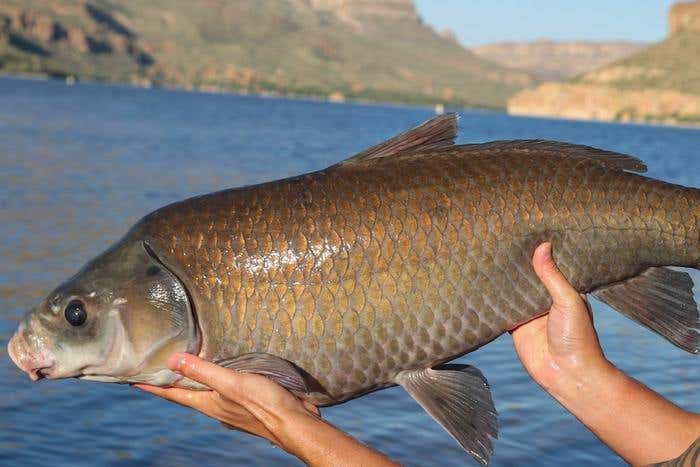Three freshwater fish species discovered to live for over 100 years
A recent study found some of the oldest animals in the world living in a place you wouldn’t expect: fishes in the Arizona desert.

[Nov. 4, 2023: Staff Writer, The Brighter Side of News]
A century-old buffalofish from Apache Lake, Arizona. (CREDIT: University of Minnesota Duluth)
It's not often that the arid landscapes of Arizona are associated with aquatic longevity. However, groundbreaking research has revealed an aquatic marvel – some of the world’s oldest freshwater fishes residing in the unexpected confines of the Arizona desert.
This discovery sheds light on a small group of fishes whose lifespans eclipse a century, presenting new horizons for aging studies across various biological disciplines, such as gerontology and vertebrate senescence.
Intriguingly, these findings center on a genus that is seldom at the forefront of scientific headlines: Ictiobus, commonly known as buffalofishes. Native to Minnesota, these species – the bigmouth buffalo, smallmouth buffalo, and black buffalo – are frequently misclassified, thus potentially overlooked as a vital resource for longevity research.
A study spearheaded by the University of Minnesota Duluth (UMD) and published in Scientific Reports brings to light this fascinating aspect of ichthyology. Spearheaded by Alec Lackmann, PhD, a seasoned ichthyologist from UMD's Swenson College of Science and Engineering, this research represents a collaborative venture bridging UMD, North Dakota State University, and a dedicated group of conservation anglers at Apache Lake in Arizona.
Related News
“There is likely a treasure trove of aging, longevity and negligible senescence information within the genus Ictiobus,” Lackmann states. This bold assertion stems from a prior discovery in 2019 that extended the known lifespan of the bigmouth buffalo well beyond the previously accepted estimate of 25 years to over a century.
This extension in lifespan was achieved through a meticulous aging technique involving otoliths, or earstones, which reside within the fish's cranium. By sectioning these stones and analyzing them under a compound microscope, Lackmann and his colleagues could discern the fish’s age with precision akin to counting the annual rings of a tree.
The fruits of this labor have yielded findings of remarkable significance:
The three buffalofish species studied boast lifespans exceeding 100 years, a longevity record for freshwater fishes.
It is plausible that some buffalofishes from a 1918 Arizona stocking event remain alive today.
A catch-and-release fishery at Apache Lake has augmented our knowledge of these species, enabling the recapture and study of centenarian fishes with distinctive markings.
Angler Stuart Black displays a spectacular centenarian bigmouth buffalo from Apache Lake, Arizona. (CREDIT: University of Minnesota Duluth)
The study exemplifies the power of citizen science, with anglers and researchers collaborating to enhance scientific outreach and education.
The odyssey of these buffalofishes is in itself a tale of survival and adaptability. Originating from central North America, the species found in Apache Lake are descendants of fishes stocked in Roosevelt Lake by the government in 1918. While Roosevelt Lake's fish populations have been depleted by commercial fishing, Apache Lake's have thrived, largely untouched until the advent of angling enthusiasts adept at catching buffalofishes on rod-and-line.
Map of Apache Lake, Arizona, USA showing recreational shore-fishing locations of Crabtree Wash (CW), Marina, Lower Burnt Corral (LBC), Upper Burnt Corral (UBC), and Chunk Beach (CB), as well as the locations where recaptures occurred throughout the study. (CREDIT: Scientific Reports)
One such enthusiast, Stuart Black, was captivated by the unique markings on the buffalofishes and, upon discovering Lackmann's research, extended an invitation to a fishing event where the collected specimens would be donated to science.
Through careful examination of the otoliths from these events, Lackmann corroborated the centenarian status of the buffalofishes in Apache Lake, a phenomenon unmatched in the freshwater world.
Thin-sectioned asteriscus otoliths (with insets) of Arizona buffalofishes. Examples are of an estimated 101-year-old male bigmouth buffalo Ictiobus cyprinellus, a 108-year-old male black buffalo I. niger, and a 101-year-old male smallmouth buffalo I. bubalus from Apache Lake, Arizona. (CREDIT: Scientific Reports)
The implications of these findings are profound. “These long-lived species of fishes and individuals could be monitored so that we can further study and understand their DNA, their physiology, their ability to fight infection and disease, and to compare these systems across the continuum of age,” Lackmann envisions. The genus Ictiobus now promises to be a goldmine for gerontological studies, with Apache Lake poised to become a scientific nexus for future research endeavors.
For gerontologists and biologists, the implications of these long-lived fishes extend far beyond the banks of Apache Lake. They carry the potential to unlock the mysteries of vertebrate longevity, offering a window into the genetic and physiological traits that confer resilience against the ravages of time.
Examples of multi-capture sequences of individual bigmouth buffalo Ictiobus cyprinellus from Apache Lake, Arizona across years. (a)–(d) An individual male was caught by four anglers on four dates across a 13-month period.. (CREDIT: Scientific Reports)
Moreover, the erroneous lumping of these species with invasive carps has often led to inadequate fishing regulations, highlighting the need for increased awareness and precise identification to safeguard these biological treasures.
Lackmann's groundbreaking work illustrates the significance of meticulous aging techniques and underscores the need for conservation-focused angling practices. The study not only contributes to the annals of ichthyology but also opens doors to interdisciplinary research with far-reaching consequences for understanding the aging process across vertebrates, potentially illuminating aspects relevant to human aging.
Alec Lackmann, PhD, is an ichthyologist and assistant professor at the University of Minnesota Duluth. (CREDIT: University of Minnesota Duluth)
As we continue to unravel the secrets of these desert-dwelling ancients, their unique biology could indeed point us toward the metaphoric 'fountain of youth' for vertebrates, including humans.
The buffalofishes of Arizona, once overlooked, could redefine our understanding of longevity, offering insights that may one day inform the science of human longevity and the quest to enhance the quality of life in our later years.
For more science and technology stories check out our New Discoveries section at The Brighter Side of News.
Note: Materials provided above by The Brighter Side of News. Content may be edited for style and length.
Like these kind of feel good stories? Get the Brighter Side of News' newsletter.



